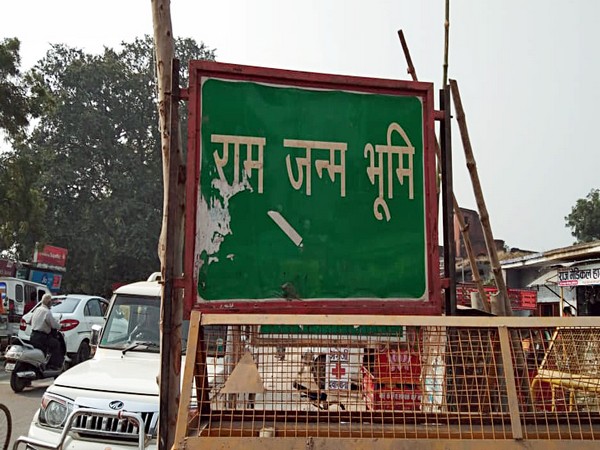AYODHYA: Supreme Court Lawyer MR Shamshad, on behalf of nine Muslims residents of Ayodhya, has written a letter to the Trustees of the Shri Ram Janmbhoomi Teerth Kshetra trust, not to use the land of about 4-5 acres around the demolished Babri Masjid for the construction of Ram Temple as the graves of Muslims are there.
Shamshad wrote the letter, dated February 15, to trustees K Parasaran, Jagatguru Shankaracharya Swami Vasudevanand, Jagatguru Madhavacharya Swami Vishwa Prasannatheerth, Yugpurush Parmanand, Swami Govinddev Giri, Vimlendra Mohan Pratap Mishra, Anil Mishra, Kameshwar Chaupal and Mahant Dhirendra Das, and ex-officio trustee District Collector, Ayodhya.
Shamshad wrote the letter on instructions of the residents of Ayodhya, namely, Saddam Hussain, Nadeem, Mohammad Azam Qadri, Gulam Moinudin, Haji Achan Khan, Haji Mohammad Laik, Khaliq Ahmad Khan, Mohammad Irfan and Ehsaan Ali.
“There can be no denial of the fact that the Babri Masjid was surrounded by Muslim graveyards from three sides,” the Supreme Court lawyer said.
“This was the only suit which was allowed by three Judges of Allahabad High Court in a particular manner and recently, the Supreme Court has decreed the same suit of Ram Lala in terms of prayers (A) and (B) which is essentially claim of the land covered in the area of the Babri Masjid,” he added.
Shamshad said that as per recorded facts, “75 Muslims were killed in the riots of 1855 and they were buried in an existing graveyard around the Mosque.”
“Even thereafter, this land was used as graveyard. Issue of this grave-yard was also the subject matter of claims by Muslims. However, after the 1994 judgement of Supreme Court in the Ismail Faruqui case, the dispute between Masjid and Ram Temple remained confined to 1480 sq. yards which has finally been resolved by a decree of the Supreme Court in November 2019,” he wrote.
He said that in 1994, the Supreme Court had upheld the acquisition of larger land admeasuring 67 acres which included the graveyard land and thus the entire land became vested with the central government.
“Now, the entire 67 acres has gone in favour of ‘Shri Ram Janmbhoomi Teerth Kshetra’ and the trust has been assigned with the responsibility to construct the magnificent Ram Temple,” he wrote.
Shamshad said that at the time when the suits were filed and Ismail Faruqui was decided, the scheme was not to hand over the entire 67 acres to the temple trust.
“That being the position of the trust, I state that the land of graveyard is a place where Muslims have been buried. Though the Mosque was not on the graveyard, but still, Suit of Lord Ram sough to justify (though wrongly) that the Mosque cannot be valid because it was surrounded by graveyards from three sides,” he wrote.
He further stated that the Act of 1993 of central government, while acquiring 67 acres of land was “not to exclude Muslims from the said land.”
“The object sought to achieve through the Act was also to construct a ‘Mosque’. This Act was upheld in Faruqui case. The central government has acted contrary to the Act of 1993 by using the discretionary power conferred to them by the strength clarification by the Supreme Court, which has in effect reviewed the Faruqui case to some extent. This was uncalled for,” he said.
The Supreme Court lawyer claimed that the “central government has not considered the issue not using the graveyard of Muslims for constructing the grand temple of Lord Ram.”
“It has violated ‘dharma’. Now, you all Trustees are persons of eminence in contemporary India and have the best knowledge and experience in the field of Hindu/Sanatan religion and practice. In view of religious scriptures of Sanatan Dharma, you need to consider whether the Temple of Lord Ram Janmsthan can have foundation on the graves of Muslims? This is a decision that the management of the Trust has to take,” he wrote.
“With all humility and respect to Lord Ram, I request you, not to use the land of about 4-5 acres in which the graves of Muslims are there around the demolished Mosque,” he added.
While concluding the letter, Shamshad wrote, “The graves may not be visible today considering the fact that the entire area has been differently treated with since 1949, when forcibly an idol of Lord Ram was placed inside the Mosque and when in 1992 the Mosque was demolished.”
The trust mandated by the central government to complete the construction of Ram temple in Ayodhya, at its first meeting is set to finalise “muhurat” for beginning construction and transparent mode for collection of funds apart from discussing future course of action.
The temple trust will have its first meeting on February 19 in the national capital with several key decisions on its agenda. The trust is expected to broadly finalise the timeline for the construction schedule of the Ram Janmabhoomi temple. The members would also be discussing the way in which funds need to be generated for the same, informed a source. (ANI)





